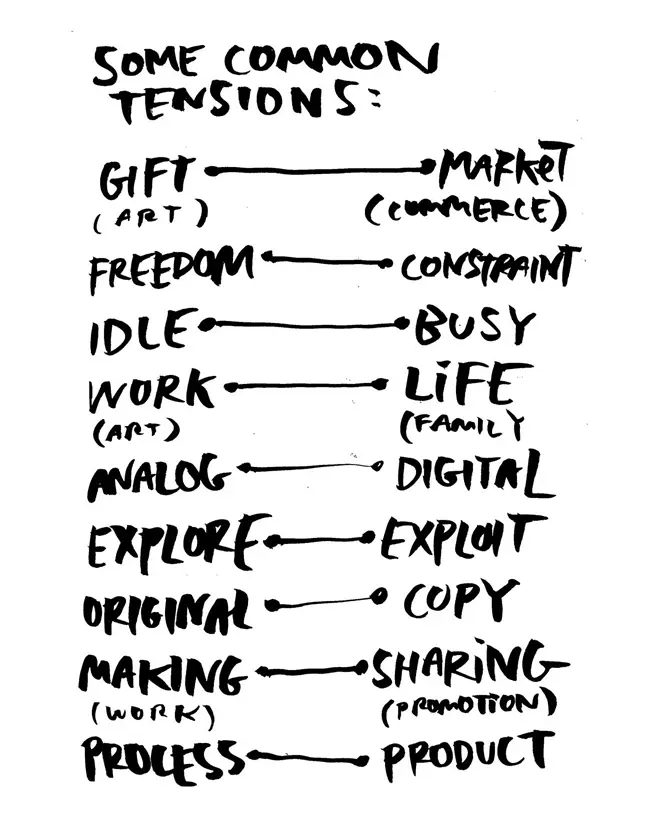
Michelangelo never wanted to paint the ceiling of the Sistine Chapel because he considered himself a sculptor. John Lennon and Paul McCartney wrote some of pop music’s most iconic songs, but they could scarcely agree on anything. And Mario Puzo never really wanted to write The Godfather, but did it because he needed money.
All of these iconic works have one thing in common: they’re products of creative tension, a situation where there is discord, or a gap, between where something is and where you want it to be.
Creative tension isn’t just limited to artists, musicians, and authors. We’ve all experienced some level of tension in our lives. In fact, the world is built on opposites: balancing family and work, spending and saving, giving and receiving. Though contradictory, we need these pairs, a concept known as “the unity of opposites.” We can’t have hot without cold, light without dark, or life without death.

But Austin Kleon, New York Times bestselling author of Steal Like an Artist, says the contemporary world struggles with tension. “The dominant cultural narrative is to get rid of tensions because they’re seen as bad,” he says. Having tension between work and life, for example, makes us feel like we’re not doing either thing right.
Kleon believes that rather than aiming to get rid of tensions completely, we should find ways to balance them. Similar to how our physical world is literally built on tension, proper tension is also needed in the way we work. For example: Do I create based on my own passions or for what my audience wants? Do I focus on creating new content or promoting existing content? Kleon believes that the best creative work comes when we draw energy from those tensions. We need idleness as much as busyness, a fulfilling career and a loving family, and the freedom of choice but also constraints to keep us on track.
Kleon’s ideas have been an inspiration for many, including French creative entrepreneur Keva Epale. For Epale, embracing tensions helped her grow from an art school student to becoming the owner of her own creative studio where she now helps other creators build their brands.
“Creative tensions have made me more resilient and empowered me to build what I want,” says Epale. “Never shy away. Acknowledge the tension. Sometimes it will be a signal to reframe your thinking. Other times it may be a sign that you are closer than you think to a creative breakthrough.”
Change your assumptions
For several years, Epale worked for an art museum in France. Though she formed strong relationships with her colleagues and gained experience working in different roles, she felt stuck. She spent all her time producing work for her job and didn’t have much room to pursue her own creative pursuits, such as starting her own company. This pushed her to quit her job and enroll in a program in Copenhagen where she spent more than three months learning the ins-and-outs of entrepreneurship.
“Being surrounded by founders and startup owners not only helped me understand how I could be useful with a graphic design background,” says Epale. “It also highlighted the fact that I wasn’t only a graphic designer and I could also be an entrepreneur.”
Epale’s approach to balancing tensions is a great example of one of the pillars of a framework outlined by Wendy K. Smith and Marianne W. Lewis, experts in the area of organizational paradoxes, in their book Both/And Thinking.
When it comes to decision-making—“Should I keep working or should I take a break and spend time with my kids?”—we often think in terms of either/or rather than both/and. But Smith and Lewis say that it’s important to change your mindset from thinking you can only do one or the other and to start thinking that you can do both. “Reframing the question will invite in a whole broader perspective on what the possible answers are,” Smith says.
A change in mindset gave Epale the permission to think of herself as more than just a designer—helping to challenge herself and grow in ways she never originally imagined. Nowadays, she considers herself not just a designer, but an art director, a brand enthusiast, an illustrator, and an entrepreneur, too.
Create boundaries
Say you run your own business selling vintage jewelry online. Or maybe you’re a self-employed wedding design consultant. You probably don’t have the same workplace constraints that come with working for an employer. But the abundance of freedom that comes from working for yourself can also mean a lack of direction.
Whether it’s taking on too many projects at once or not knowing what to prioritize in a day, Smith suggests creating guardrails to keep yourself on track—both short and long term. For example, if you don’t want to feel burnt out in five years, you have to make changes to your life today. “Maybe that's turning off your phone when you get home from work or taking a day off where you really unplug,” says Smith.
For Epale, one of the first things she did after she quit her job and started freelancing was create a manifesto, as she likes to call it. This helped her set boundaries and guided the direction she went in as she started to build her portfolio of work.
The manifesto “included things like what kind of designer I want to be and which kinds of brands or companies I want to work for,” Epale says. “I wanted to find my place, but still play within that.”
Setting these boundaries helped Epale create a clear identity for herself and her work. Since realizing her dream of owning her own creative studio, she now only takes on clients and work that aligns with her ethos.
Find comfort in discomfort
That’s not to say the work always comes easily. Epale used to find when her work didn’t turn out the way she wanted it to, it was difficult for her to move forward.
“For a number of years, I thought I was just a procrastinator,” she says. “I would start something and never really finish it. But I really had to stop beating myself up for that.”
Something that can help you move forward, according to Smith, is recognizing and acknowledging that discomfort. “If we pretend those emotions don't exist, they only come back stronger,” Smith says. “We need to literally tell ourselves, ‘Yes, I feel uncomfortable. Yes, I'm feeling fear. Yes, I'm honoring that.’”
What Epale found to be the most effective was to let go of the how in how her projects would turn out. She shifted her focus towards the why and the what, letting those questions guide the material she would put out. And even if the outcome was imperfect, which it often was, she was still satisfied because she knew she gave it her all.
Once Epale came to terms with not finishing something, she actually started feeling a lot more freedom, which allowed her creativity to flow—even if the end result was different from what she initially envisioned “I now have this understanding that it’s okay if I can’t do something fully,” she says. “I believe an idea is never in vain. There's a perfect time for it to birth and it’s okay if it’s not now.”
Be dynamic
Finding balance in creative tensions isn’t an overnight feat—or even something you only ever do once—but an ever-evolving journey that will look different for every person.
“It means having a mindset where you're constantly and able to rethink, experiment, and try new things,” Smith says. “It's the idea of moving from ‘I found a balance or a solution’ to ‘I'm constantly balancing, rethinking, and solving.’”
A metaphor Smith uses to help her readers understand this concept is that of a tightrope walker. In order for the tightrope walker to move forward, they need to be constantly balancing rather than being fully balanced; in fact, if they were fully balanced, they’d fall.
“We’re not always making decisions,” she says. “What we're doing is we're shifting over time between competing demands.”
So the next time you’re feeling a bit stuck or torn between where you are and where you want to be, just remember that the tension you’re feeling is a normal part of life. Whether you’re a budding solopreneur trying to start your own company or a creative who’s trying to expand your existing business, the best thing to do is to embrace the tensions.
“Not only is it unavoidable, it’s necessary to do great work,” says Kleon. “What’s needed isn’t the avoidance of tension, but the harnessing of them and getting the proper tension to bring forth your best work.”













.png/_jcr_content/renditions/hero_square%20(1).webp)

.png/_jcr_content/renditions/hero_wide%20(1).webp)



.png/_jcr_content/renditions/hero_square%20(3).webp)
.png/_jcr_content/renditions/blog%20(1).webp)

.png/_jcr_content/renditions/hero%20(1).webp)
.png/_jcr_content/renditions/hero_wide%20(1).webp)














































.png/_jcr_content/renditions/1080x1080%20(1).webp)










.gif)







































































.png)
.png)
.png)
.jpg)
.jpg)













































































































































































































































































































































































